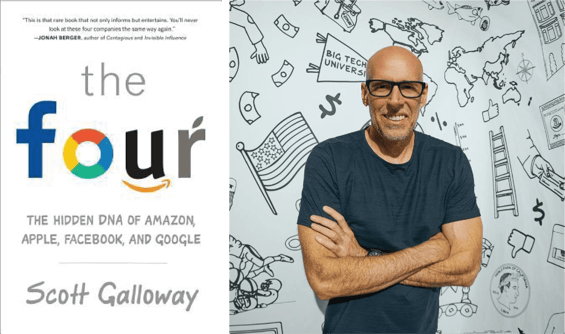This image is a visualisation of friendships represented by Facebook developed by an intern (Paul Butler) back in 2010. Little did we realise the impact vast computing power would have on today’s society, commerce and well-being when applied to human social networking.
Chances are you’ve heard the term “the big four” used in reference to the largest accounting services firms in the world. Today, in the context of the 4th Industrial Revolution, this term refers to the market capitalisation of the four trillion-dollar digital companies: Amazon, Apple, Facebook and Google (or Alphabet). These giants have come to dominate global commerce - in ways that were previously hard to imagine – by leveraging the new paradigm of practically-infinite computing, high-speed connectivity delivered via smart-mobile devices and sensors.
 Book recommendation on the origins of the platform business model
Book recommendation on the origins of the platform business model
This paradigm has put a mobile device in the hands of well over half the world’s population, with in excess of 6 billion smartphones having shipped as at 2020. It means that virtually anyone or any organisation can deploy on-demand, scalable cloud computing power in minutes – vastly lowering the barriers-to-entry for digital business services.
The rise of Amazon Web Services is an example of a start-up corporation figuring out how to leverage their investment in digital infrastructure and repurpose the use of that capital to create an entirely new revenue stream – and change the return on capital equation. This approach is emblematic of the platform business model, which we will discuss in more depth in subsequent chapters.
As 5G rolls out across mobile networks, we are seeing a three-fold increase in both broadband and mobile speeds over the five years between 2018 and 2023. It’s significantly changing what’s possible in both the supply and demand of digital business services - wherever we happen to be.
As we emerge from the pandemic and establish the next normal, flexible hybrid-modes of delivery and consumption will be underpinned by substantially faster connectivity, on-demand cloud computing, smart devices and miniature IoT sensors.
The economic models, coupled with the technology of the 4th Industrial Revolution, are seeing an erosion of the traditional barriers to competition. This is especially true in Asset Intensive Industries. Historically, the large scale of capital required to build the infrastructure for the provision of a service, utility or product was sufficient to create a barrier to competition. The advent of upstart enterprises like Amazon (taking on the traditional bricks and mortar book retailers), Uber (challenging the hegemony of the taxi business in given locales) and Tesla (beginning with electric vehicles, and rapidly moving into the self-driving transport realm), has dramatically shifted the playing field for incumbent retailers, transport providers and vehicle manufacturers. There are a couple of stand-out things that these enterprises all have in common: they are awash with capital, and they are second-to-none in their adoption of digital platforms for delivery, service and operations.
Incumbent enterprises with costly, hard to build investments in infrastructure have historically enjoyed insulation from competition. Part of this infrastructure is the proprietary Information Technology and Communications Networks, processes and retained intellectual capital associated with them. With the cost of computing, storage and wireless communication on a path to near zero cost, a key lever that enterprise had to defend from disruption is being relentlessly eroded. Perhaps the easiest way to conceive this notion is in converse: what if Moore’s Law applied to all technology?
Sam Altman in Moore’s Law of Everything argues that there will be a shift in the socio-economic paradigms that underpin business and society - changing the economic and political landscapes forever - as the price of fundamental technologies head toward zero cost.
The essential message here is that incumbent enterprises need to recognise these macro-level shifts, and in turn adapt their business operations model to meet this challenge and create competitive differentiation that is fit-for-purpose in the context of the cyber-physical world of the 4th Industrial Revolution.
The opportunity that lies in leveraging the shifts in computing, connectivity and devices goes beyond adopting technology for its own sake. It lies in the two fundamentally different approaches to overall business endeavours: Management vs. Entrepreneurship. Applying the principles of each will enable quite different outcomes and Return on Investment equations.
1. Optimise, Modernise, Leverage your existing investments
Embrace your historic competitive advantage and sunk costs through adopting strategies to squeeze everything you can out of existing infrastructure, while grafting digital technology onto these assets, systems and processes. This efficiency-gain approach has a comparatively low capital cost associated with it, enabling you to defend from competitive disruption. The perspective applied is that of short-term gains with low-risk tactical investments.
From an infrastructure standpoint, using what you have and complementing it with the use of new technologies with small, sustained gains over time will deliver a compound advantage. Faster wireless connectivity may deliver a notional improvement, but when combined with faster smart devices and on demand computing power, you achieve a significant operational improvement.
2. Transformative Innovation
This looks at both the macro-level changes and long-term shifts that are afoot, in order to transform your business model to meet the demands of the emerging digital business landscape. This is comparatively an offensive strategy to digital disruption. The perspective applied is long-term gains, balanced by a spread of low-risk experimentation.
How Today's Entrepreneurs use Continuous Innovation to Create Radically Successful Businesses
This strategy requires quite different paradigms to be applied both in terms of the acquisition and utilisation of resources – across the spectrum of financial capital, human capital and intellectual capital. Business model innovation has quite a different mode of operation to business-as-usual innovation. The style of management is much more akin to the start-up world and often referred to as lean methodology, popularised by Eric Reis in his book, The Lean Startup:
Internal IT and communications requirements have historically required high investment in both working capital and intellectual capital, creating the perception of a slow, undynamic, risk-averse department that stands in the way of innovation. Most IT departments are not geared to providing digital services for Transformative Innovation. Realizing the comparative inflexibility of internal (proprietary) software development initiatives, IT Department Managers have learnt from Silicon Valley Software Development teams, and adopted Agile where applicable, to create better, more flexible service delivery to the enterprise.
The challenge confronting IT in the digital business mode of operation is how to provide a hybrid model for both a defensive business strategy that optimises, modernises and leverages existing investments, as well as an offensive business strategy that allows for transformative business model innovation. As discussed above, these two modes of working are very different, the resources needed are very different, and the business mindset is very different.
The promise of hyper-scalable, flexible, on-demand computing for digital business, coupled with vast arrays of sensors, devices and proliferation of smartphones is substantial. The resistance of incumbent institutions, organisations and enterprises to change virtually guarantees the rise of upstarts leveraging better, faster, cheaper digital infrastructure.
The opportunity in the enterprise is to leverage its incumbent position while embracing these new modes of operation. From the IT department’s perspective, the opportunity lies in how to provide service models that enables both – not by doing it themselves, but in adopting a platform services model that has a supporting ecosystem of aligned partners from different disciplines. More on this in subsequent chapters.
The third way is delivering the digital infrastructure that safely enables both sustaining near-term innovation and transformative long-term innovation, along with the strategic mid-term innovation. Central to creating this third way is understanding the fundamental shifts in business models that we are seeing as a consequence of exponential change and new business paradigms of the 4th Industrial Revolution.
In the next chapter we will delve into the rise of cyber-physical systems and what that means to enterprise innovation and digital business transformation.
For further reading on adapting enterprise business practice to embrace innovation and compete in an age of disruption - check out Geoffrey Moore's "Zone to Win":
NASA Astronaut Mike Mullane shares how His experiences in high-pressure situations have given him a unique perspective on being agile while managing risk.
The modern CFO must now leverage their understanding and use of technology to help drive business strategy. They need to be business-focussed technologists.
James Slezak helped The New York Times innovate and adopt a digital business model to invest and prosper in the face of disruption.
Please complete this form if you're ready to take part in the complimentary program of on demand talks, interactive workshops and LIVE ideation hackathon - as well as access useful Digital Transformation frameworks, methodologies and resources.